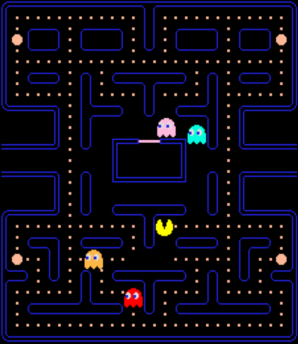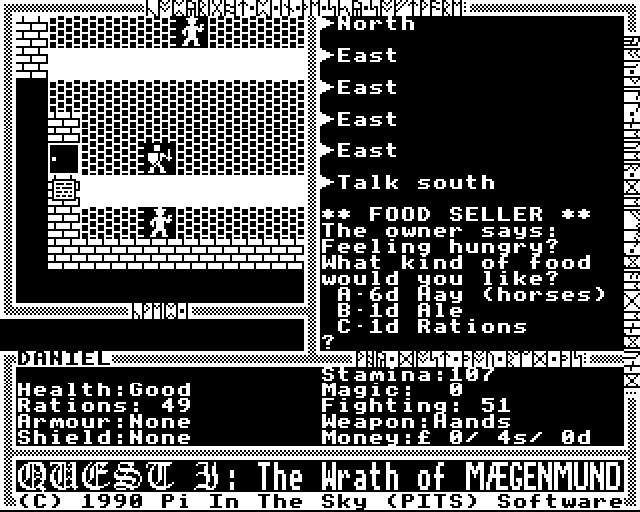If you’re a Lego geek, and in Melbourne tomorrow, Brickvention 2006 is open from 10:00-15:00 at Melb Uni. $5 Adults, $2.50 kids.
Category Archives: Nostalgia
Bored with Rubik’s cube?
So is the standard Rubik’s cube so easy that you’re bored with it? Can you solve it in 12.1 seconds?
Well, try your hand at a 4D Rubik’s cube.
Then, if your head hasn’t exploded, check out the 5D Rubik’s cube! From the site: “In the spirit of taking things too far, here is a fully functional 5-dimensional analog of Rubik’s cube.”
Sadly, 5 people have already solved the 5D cube. You can’t be first.
Documentary on Adventure Games
The guy that brought us a documentary on Bulletin Board Systems is now at work on documentary on text adventure games. I believe it’s going to be released under the Creative Commons license, and shot in stunning HiDef, those talking heads are going to look really nice. Adventure games are, apparently, known as interactive fiction. I never thought of it like that.
Ah, Zork. Is there anything you can’t teach us about ourselves? Not like that goddamned HHGTTG, with it’s prescriptive plotline – what a POS.
The rise and fall of Commodore
“On The Edge: The Spectacular Rise and Fall of Commodore” tells the oft-missed-by-the-geek-historians story of Commodore. The web site has some free chapters, including one describing the creation of the Commodore 64:
If you’ve ever wondered why the C64 has the same case as the VIC-20, it’s because we didn’t have any time to tool anything up. We just put it in a VIC-20 case and spray painted it. Everything about the Commodore 64 is the way it is because of just an unbelievably tight time constraint on the product.
RIP Neil Raine
You may not have heard of Neil Raine… sadly neither did I until today. He died on Wednesday in a hang-gliding accident in Spain. His role in the geek world? He was a contributor to RISCOS, the operating system of the Acorn Archimedes range, the first consumer computer to use a RISC processor, way back in the late 80s.
He also contributed a number of games that BBC users might recall, including Hopper, Planetoid and one of my personal favourites, Magic Mushrooms, a platform game that allowed you to design your own levels.
Neil may not have been rich or famous, but geeks like him make an untold contribution to the world of computing. Here’s to you, Neil.
The legend of Llamasoft
I’ve discovered that though Way Of The Rodent started publishing Jeff Minter’s auto-biographical history of Llamasoft, there’s actually more on the Llamasoft web site.
I’d thought I was good at Space Invaders until I met Chico. He was so good at Space Invaders that he could play it forever – it was no longer a challenge to him at all. So if he played the game at all he’d set himself some task that us mere mortals simply could not even begin to comprehend. Shooting all the Invaders was too simple. He’d time his shots so precisely that he could shoot individual Invaders out of the flock to eventually form his initials from the remaining attackers.
A buncha quick stuff
EFF highlights an Australian House Standing Committee report on the US DMCA, and whether or not it should be adopted wholesale by Australia under the Free Trade Agreement.
Meanwhile there’s an open letter to the OFLC about the banning in Australia of the grafitti video game Getting Up: Contents Under Pressure. (Mind you, Metacritic only gives it a 73/100 on XBox; 70 on PS2).
OPML 2.0 is out. Let’s hope it doesn’t break OPML 1 like RSS 2 broke RSS 0.9?
The Age on the retro games boom.
Pah, this sucks. After 64 years in Swanston Street, the Technical Bookshop in Melbourne has moved out to the boondocks of LaTrobe Street near Queen Street.
BBC BASIC for Windows
For die-hard BBC BASIC lovers, there’s a version for Windows which can be used to create fully-blown Windows applications, producing small standalone EXEs.
There are also implementations available for MS DOS, Mac and other platforms. (Though really, to do anything good, sounds like it’d be a hard slog. Personally I’ll probably stick to VB, despite the runtime libraries required.)
Where to rest in Pacman
 Obviously if you’re playing in MAME you can just press P to pause, but on a real Pacman arcade game, what do you do if you’re playing a mammoth game and you want to rest? Go just to the right and up from the starting position.
Obviously if you’re playing in MAME you can just press P to pause, but on a real Pacman arcade game, what do you do if you’re playing a mammoth game and you want to rest? Go just to the right and up from the starting position.
The ghosts won’t find you, you can rest for a while.
That’s certainly something I wish I’d known 20 years ago…
How the original Doctor Who theme music was done
Doctor Who Restoration Team member and professional TV/film/multimedia composer Mark Ayres has a comprehensive history of how the original Doctor Who theme music was done.
There being no “synthesisers” [in 1963], the Workshop needed a source of electronic sound. They found this in a bank of twelve high-quality test tone generators, the usual function of which was to output various tones (square waves, sine waves) for passing through electronic circuits for testing gain, distortion and so on. They also had a couple of high-quality equalisers (again, test equipment – equalisers, or “tone controls”, were not that easy to come by at the time) and a few other gadgets including a “wobbulator” (a low frequency oscillator) and a white noise generator.
Moving files from BBC Micro to PC
Well I’ve finally done it, transferred my old Ultima BBC clone game “Quest” onto the PC, so it’s now playable in a BBC Micro emulator such as BeebEm.
First thing to do was get the two beasts talking to each other. Unlike many 8-bit computers, the Beeb was blessed with a relatively standard serial port, the RS423 which is basically a cut-down version of the RS232 serial port we’ve all grown to know and love on modern PCs. Fortunately I had an old RS423 (DIN-5) to 25 pin modem cable I could use. I got hold of an old null modem, and the right combination of 25 pin to 9 pin adapters and gender changers to plug it into the PC, and Bob’s your uncle.
Except it wasn’t quite that simple. The software I tried out, XFer (later version here), which would transfer whole disks from the Beeb across the wire, wouldn’t work. Turns out it doesn’t like the standard cables, but wants something special.
I’m not much of a hardware-type person, so I elected to find other software that would do the job. I ended up with an ancient BBC Kermit ROM (actually a sideways ROM image, if you know what that is; if not I’m not going to explain it right now) that I had, talking to Windows 2000 Hyperterminal on the PC.
They would talk at a max baud rate of 9600, which is pretty damn slow, but hey, we’re talking disks of a max 200Kb a side here.
Oh, if you try this, be very careful to SET FILE TYPE BINARY in Beeb Kermit.
There was, however, a problem in that after a period of time, the old BBC disk drive started smelling funny, and smoke started coming out. Seriously.
I had to shut it down for a while to calm it down, and from that point on I was doing things bit by bit, and letting it rest in between.
Once the files were across, I needed to run an *INFO on the Beeb to get a look at their attributes. BBC files have a load and execute address that’s important to let the Beeb know what to do with the file when it’s loaded. A BASIC file, for instance, is normally loaded at &FF1900 and has an exec address of &FF8023. Without these, the files don’t work very well.
The way the Beeb emulators work with this is to look for an INF file for each file, which contains the load and execute addresses. Once I’d figured this out, I could read them into a BBC disk image creator (there’s two that I found: BBC Explorer, and DFS Explorer — the latter under active development, with the author helpfully answering my questions).
Battling dodgy 15-year-old disks, I gradually got all the files I needed for the game across. I did find the latest version wouldn’t run properly, but a slightly older one did run okay… even if it brought back memories of bugs that I’d obviously intended on fixing when I last looked at the code, back in May 1990.
For those with the energy to try it, the game (in all its bugridden glory) will be made available by the BBC games archive site Stairway To Hell shortly.

Playing Quest
Once you load the disc image into BeebEm, you will need to turn off Write Protect on drive 0, as the game periodically saves the character’s progress.
Some of the keys are a little unresponsive in BeebEm. Hold down the space bar to stop the horrible music at the title screen!
There are a number of bugs, the most serious being if you try and enter a village/town for which no map was defined, it tries to send you straight past it without stopping. If this results in you going into a spot on the map you can’t walk on (such as water) it goes into an infinite loop. To get out of this, press Escape, then CHAIN “BS” which will go back to the last save.
Controls:
- cursor keys or ; [ ‘ / to move
- G get
- A attack (useful to go into the starting town and find some
- weapons/armour first)
- S status
- Q save (and quit)
- U use weapon
- W wear armour
- V view document
- R read sign
- T talk to someone
- C cast spell
There’s a lot of characters to talk to, and clues lying around, but I honestly don’t remember how far we got the plot developed.
Enjoy!
Classic computers calendar
Ooh, this could be the perfect Christmas present for your local geek: The Classic Computers calendar for 2006. Note the cheeky side and back-end/cable socket views of the boxes.
